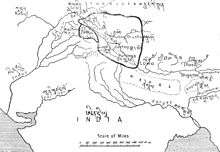Namgyal dynasty of Ladakh
| Namgyal dyansty of Ladakh | |||||||
|---|---|---|---|---|---|---|---|
| 1460–1842 | |||||||
| Religion | Tibetan Buddhism | ||||||
| Government | Monarchy | ||||||
| History | |||||||
• Established | 1460 | ||||||
• Disestablished | 1842 | ||||||
| |||||||
The Namgyal dynasty of Ladakh was founded by Bhagan, a Basgo king, who reunited Ladakh by overthrowing the king of Leh. He took the surname Namgyal (meaning victorious) and founded a new dynasty which still survives today. King Tashi Namgyal (1555-1575) managed to repel most Central Asian raiders, and built a royal fort on the top of the Namgyal Peak. Tsewang Namgyal temporarily extended his kingdom as far as Nepal.


Sengge Namgyal (r. 1616-1642), known as the 'Lion' King made efforts to restore Ladakh to its old glory by an ambitious and energetic building program including the Leh palace and the rebuilding of several gompas, the most famous of which are Hemis and Hanle.[1]

He expanded the kingdom into Zanskar and Spiti, but was defeated by the Mughals, who had already occupied Kashmir and Baltistan. His son Deldan Namgyal (1642-1694) had to placate the Mughal emperor Aurangzeb by building a mosque in Leh. However, he defeated the Mughal army in Baltistan. His son Delek sided with Bhutan in a religious dispute between Tibet and Bhutan, which resulted in an attempted invasion by the fifth Dalai Lama. The Moghuls withdrew after being paid off by the 5th Dalai Lama.[2] With the help of reinforcements from Galdan Boshugtu Khan, Khan of the Zungar Empire, the Tibetans attacked again in 1684. The Tibetans were victorious and concluded a treaty with Ladakh then they retreated back to Lhasa on December 1684. The Treaty of Temisgam in 1684 settled the dispute between Tibet and Ladakh, but its independence was seriously restricted.
By the beginning of the 19th century, the Mughal empire had collapsed and Sikh rule had been established in Punjab and Kashmir. However the Dogra region of Jammu remained under its Rajput rulers, the greatest of whom was Maharaja Gulab Singh (1792-1857)——his General Zorawar Singh invaded Ladakh in 1834. King Tshespal Namgyal was dethroned and exiled to Stok.
List of kings
The kings of Namgyal dynasty along with their periods of reign are as follows:[3]
- Lhachen Bhagan (c. 1460-85)
- Unknown (c. 1485-1510)
- Lata Jughdan (c. 1510-35)
- Kunga Namgyal I (c. 1535-55)
- Tashi Namgyal (c. 1555-75) son
- Tsewang Namgyal (c. 1575-95) nephew
- Namgyal Gonpo (c. 1595-1600) brother
- Jamyang Namgyal (Jams-dbyang-rnam-rgyal, c. 1595-1616) brother
- Sengge Namgyal (Seng-ge-rnam-rgyal, first time, 1616–23) son
- Norbu Namgyal (1623–24) brother
- Sengge Namgyal (second time, 1624–42)
- Deldan Namgyal (Bde-ldan-rnam-rgyal,1642-1694) son
- Delek Namgyal (Bde-legs-rnam-rgyal, c. 1680-91) son
- Nyima Namgyal (1694-1729) son
- Deskyong Namgyal (1729–39) son
- Phuntsog Namgyal (1739–53) son
- Tsewang Namgyal (1753–82) son
- Tseten Namgyal (1782-1802) son
- Tsepal Dondup Namgyal (1802–37, 1839–40) brother
- Kunga Namgyal II (1840–42) grandson
See also
Footnotes
- ↑ Rizvi (1996), p. 69.
- ↑ Johan Elverskog (6 June 2011). Buddhism and Islam on the Silk Road. University of Pennsylvania Press. pp. 223–. ISBN 0-8122-0531-6.
- ↑ Petech, Luciano (1977) The kingdom of Ladakh c. 950-1842 A.D. Roma: IsMEO, p. 171-2.
References
- History of Ladakh
- Rizvi, Janet ; Ladakh: Crossroads of High Asia. Second Edition. (1996). Oxford University Press, Delhi. ISBN 0-19-564546-4.
- History of Sikkim
- Sikkim